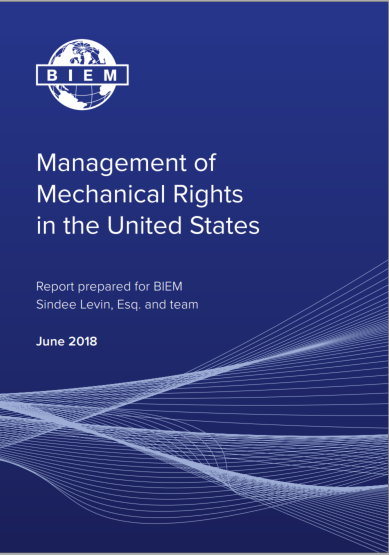
Mechanical Rights in the USA
GUIDELINES for the MANAGEMENT of MECHANICALS under the MMA
Dec. 2020 - How to conduct business in the US under the MMA #1
April 2021 - How to conduct business in the US under the MMA #2
US MUSIC MODERNISATION ACT (2018) & BIEM and CISAC comments to the US Copyright Office (USCO) notices
In October 2018, the Music Modernization Act (MMA) was passed into Law.
The MMA specifically directs the Copyright Office to adopt a number of regulations to govern the new blanket licensing regime, including regulations regarding notices of license, notices of non-blanket activity, usage reports and adjustments, information to be included in the mechanical licensing collective's database, database usability, interoperability, and usage restrictions, and the handling of confidential information. The statute also vests the Office with general authority to adopt such regulations as may be necessary or appropriate to effectuate this new blanket licensing structure.
To promulgate these regulations, the Copyright Office seeks public comments on various subjects of inquiry. In response to the inquiries, BIEM and CISAC prepare the following submissions : Enforcement of the MMA and Implementation of the MLC

Report on the Management of MR in the USA (2018)
The BIEM Report on the Management of MR in the USA (prepared for BIEM by Sindee Levin, Esq and team) covers both offline and online aspects of mechanical rights management. It also discusses the new bill (Music Modernization Act – MMA), which was still at the stage of a law proposition, when the report was finalised.
The report includes a two-page guideline to quickly understand how to conduct business in the US mechanical market.
In November 2018, a complement to Sindee Levin's report is published, after the MMA passed into law


What is Controlled Composition Clause?
North American record producers insert a “controlled composition clause” into contracts that they conclude with a performing artist or with the person in charge of the artistic direction of a recording.
Under this clause, the record producer provides that it will pay a lower mechanical reproduction right royalty than the one that would normally be applicable for the works appearing on the recording(s) covered by the contract and controlled by the artist or the artistic director, i.e., essentially, the works which he or she authored or co-authored.
The “controlled composition clause” typically provides that, for the works concerned, the record producer will have to pay the collective management society or the publisher, only 75% of the statutory rate under the statutory licence in force in the United States for copies sold in the USA.
Moreover, the controlled composition clause usually provides that the calculated remuneration will apply only to a maximum number of controlled works (generally 10 or 12), even if the album forming the subject of the contract contains a larger number of reproduced works. For example, if an artist performs 13 works written or co-written by him or her on the same album, the remuneration will be calculated only on 10 works and no remuneration will be paid on 3.
The clause applies only to works that are “controlled” by the artist or director, i.e. normally the works of which the artist or director is the author or co-author, and, in the latter case, only to the corresponding share of the remuneration payable to him or her and to his or her publisher.